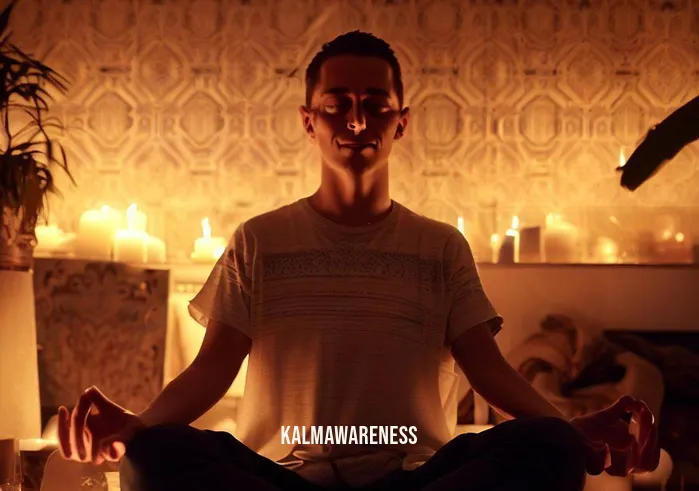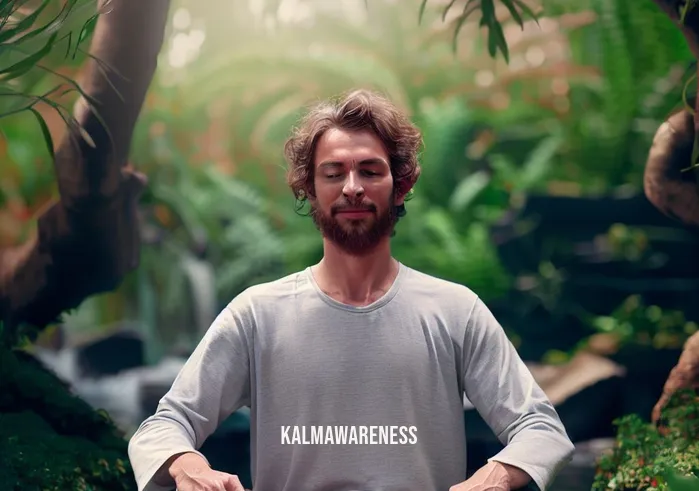The Transformative Power of Comfort Meditation: A Journey to Relaxation and Tranquility
In the age of constant distractions and overwhelming stress, the need for focused relaxation is more urgent than ever. Imagine a world where you can flick a mental switch and find yourself in a haven of peace, divorced from the chaos of everyday life. This isn’t a distant dream, but a practical reality attainable through the discipline of comfort meditation. This holistic practice is about more than just superficial relaxation; it aims for deep-seated tranquility, nurturing your mind and body, and offering you a sense of serenity and ease. This article takes a deep dive into the different aspects of comfort meditation, aiming to provide you with the knowledge and tools you need to start your journey.
The Landscape of Comfort Meditation
Meditation itself is a term that covers a wide array of techniques, some more traditional, such as EMDR Meditation, and others more modern like Floating Meditation. Comfort meditation, however, is especially geared towards people seeking a path to deep relaxation. This specific approach encourages a state of nurturing, allowing you to unwind and refresh mentally, emotionally, and physically.
The Elements of Comfort: Breathing and More
A fundamental aspect of comfort meditation lies in the practice of controlled breathing. By inhaling and exhaling consciously, you focus your mind and prepare your body for deeper relaxation. This is not a new concept; it’s actually foundational to many meditation practices like Mind Breaths. Breathing techniques in comfort meditation serve as a gateway to attain tranquility and calmness.
- Inhale – Deeply and slowly inhale through your nose, visualizing positive energy entering your body.
- Hold – Pause for a moment, keeping the air inside, and feel the tension release.
- Exhale – Slowly exhale through your mouth, imagining all stress and negative thoughts leaving you.
- Pause – Before taking the next breath, experience the sense of calm enveloping you.
“Breathing in, I calm my body. Breathing out, I smile. Dwelling in the present moment, I know this is a wonderful moment.”
— Thich Nhat Hanh
The Versatility of Comfort Meditation
What’s beautiful about comfort meditation is its adaptability to different life scenarios and needs. Whether you are suffering from Adult ADHD or looking for ways to manage migraine through binaural beats, there is a form of comfort meditation suited for you. You can even incorporate movement into your meditation practice, enhancing your mental and physical well-being through Mindful Movement for Better Sleep.
How About Meditating in Different Postures?
Contrary to popular belief, meditation doesn’t require sitting in a specific pose for an extended period. Some people find immense comfort meditating while lying down. If this method resonates with you, explore the details in Can You Meditate While Lying Down? to maximize your relaxation experience.
The Influence of Surroundings
Your environment plays an important role in the effectiveness of comfort meditation. Inviting tranquility into your surroundings by Clearing Energy Through Meditation can enhance your overall experience. Moreover, you can even adapt the practice for specific settings like travel, using methods like Flight Rising Meditation to find your center even when in transit.
Why Take This Journey?
At its core, comfort meditation aims to guide you to a state where your thoughts are not occupied by worry. It offers a break from the fast-paced nature of contemporary life and provides a sanctuary for your mind and body. But the benefits don’t just stop here. In the next segment, we will delve into the profound scientific backing of comfort meditation and its long-term impacts on health and well-being.
For now, remember that comfort meditation is not just a tool but a journey to deeper realms of relaxation, serenity, and self-awareness. If you’re ready to explore this journey further, continue reading to uncover the science behind these practices and how to implement them effectively in your daily life.

The Scientific and Holistic Aspects of Comfort Meditation: Expanding Your Practice
In the previous segment, we laid down the foundational elements and benefits of comfort meditation. Now, let’s delve deeper into the scientific backing and holistic elements that make comfort meditation a transformative experience. By incorporating data, broadening our understanding of different methods, and even using other forms of meditation to complement our primary practice, we create a well-rounded approach to achieving inner peace and relaxation.
The Scientific Endorsement of Comfort Meditation
The advocacy for comfort meditation isn’t merely anecdotal; it has garnered scientific validation. Research indicates a notable reduction in symptoms of stress, anxiety, and even chronic pain, supporting the importance of incorporating practices such as hand yoga poses into your routine for comprehensive well-being. Let’s delve into some key studies and statistics that underscore the significance of comfort meditation.
| Study / Research | Findings | Relevance to Comfort Meditation |
|---|---|---|
| Mindfulness-Based Stress Reduction (MBSR) | Reduced stress and improved mental well-being | Incorporates mindful breathing and other comfort meditation techniques |
| Cognitive Behavioral Therapy (CBT) & Meditation | Efficacy in treating anxiety disorders | Demonstrates the power of mind-body techniques |
| Meditation & Chronic Pain | Reduced perception of pain | Highlights the role of mental conditioning in physical sensations |
| Sleep & Meditation | Improved sleep quality | Comfort meditation techniques like deep breathing can aid sleep |
| Meditation & Heart Health | Reduced risk of cardiovascular diseases | Emphasizes the role of mental well-being in physical health |
Holistic Techniques to Amplify Your Experience
Just as there are various styles of painting that create different visual experiences, there are multiple techniques within comfort meditation that serve different aspects of well-being. If you’re looking to add a spiritual layer to your practice, you might find solace in connecting with the celestial via Angel Muriel meditation. For those grappling with fertility issues or the emotional weight of conceiving, Conception Meditation offers a specialized focus.
Creating the Ideal Environment for Comfort Meditation
- Energy Clearing: Before you begin, consider clearing the energy in your space to create a calming environment.
- Essential Oils: Aromatherapy can amplify the relaxing effects of your meditation.
- Soft Lighting: Dimmed lights or candles can make a significant difference in setting the mood.
Making Your Practice Child-Friendly
Don’t forget the younger members of your family. Practices like Kid Calm are designed to introduce children to the calming and peaceful benefits of comfort meditation.
Alternative Practices to Complement Comfort Meditation
While comfort meditation serves as an excellent standalone practice, its benefits can be complemented by other forms of mindfulness. For example, if you’re seeking to be more present in your daily activities, Relax and Be Aware offers techniques that work hand in hand with comfort meditation. Likewise, if you find yourself prone to worry, learn how to Be Peaceful to enhance your comfort meditation sessions.
Moving Meditation
If you find it challenging to sit still for extended periods, you can also engage in moving meditation. This is especially useful for people who wish to incorporate meditation into their physical activities.
Note: Moving meditation doesn’t have to replace your comfort meditation routine but can be used to supplement it for an enriched experience.
Can You Meditate While High?
For those curious about the intersection of mindfulness and altered states of consciousness, exploring the possibility of whether one can meditate while high can open up interesting avenues of inner exploration.
Continuing Your Journey
The scientific validation and array of techniques available make comfort meditation a versatile and robust practice for achieving tranquility, nurturing your inner self, and finding ease in your everyday life. But how do you maintain consistency in your practice, and what are the tools and platforms that can aid you? If these questions interest you, continue reading to discover various resources and strategies that will help you in sustaining your comfort meditation practice over the long term.

Drawing Hope and Inspiration from Comfort Meditation
One of the most powerful aspects of comfort meditation is its capacity to infuse our lives with hope and inspiration. Far from being a mere practice of tranquility and relaxation, it becomes a wellspring for renewed vitality and emotional resilience. As we delve into this segment, we’ll explore how comfort meditation serves as a conduit for inspiration and how it can be a catalyst for profound life changes.
Words of Wisdom: Comfort Meditation and Hope
As the adage goes, “Words have the power to both destroy and heal. When words are both true and kind, they can change our world.” In the context of comfort meditation, words of wisdom can serve as a source of inspiration. Below are some quotes that resonate deeply with the essence of this practice:
- “In the midst of movement and chaos, keep stillness inside of you.” – Deepak Chopra
- “Do not let the behavior of others destroy your inner peace.” – Dalai Lama
- “Peace comes from within. Do not seek it without.” – Buddha
These quotes not only encapsulate the philosophy behind comfort meditation but also serve as mantras that you can incorporate into your practice. For example, during a desert meditation session, you might find solace in reciting Deepak Chopra’s quote to evoke an inner oasis of calm amidst external turmoil.
A Haven for Those with Special Conditions
Comfort meditation isn’t just for those seeking general serenity and ease. Its adaptability makes it useful for people dealing with specific conditions, like Adult ADHD. The beauty of comfort meditation is that it can be tailored to serve unique requirements. For instance, ‘The Mindfulness Prescription for Adult ADHD’ outlines strategies that work remarkably well in conjunction with comfort meditation. By applying the mindfulness techniques tailored for Adult ADHD, individuals can find a form of respite that addresses their special needs.
Embracing Serenity Through Various Forms
There is something profoundly beautiful about the flexibility of comfort meditation, as it allows each person to find their unique path toward serenity. For some, it may involve floating meditation that lifts one into a state of weightlessness and peace. For others, it may be the focused awareness on the soles of the feet to ground oneself in the present moment.
Aligning Breath with Mindfulness
“The breath is the intersection of the body and mind.” – Thich Nhat Hanh
In line with this quote, you can integrate comfort meditation with focused breathing methods to cultivate mindfulness. The practice of mind breaths harmonizes well with comfort meditation, teaching you to breathe with awareness and intention.
For Those Who Are Always On the Move
In today’s fast-paced world, it’s common to seek relaxation while traveling or during work. The beauty of comfort meditation is that it doesn’t always require a secluded environment. Techniques like Flight Rising Meditate allow you to practice meditation in various settings, proving that tranquility is accessible anytime, anywhere.
Explore the Unexplored: Next Steps
The preceding chapters have laid the groundwork for understanding comfort meditation, emphasizing its scientific backing and highlighting its versatility. As we’ve discovered, it’s not just a practice but a transformative experience. This chapter shed light on its ability to inspire and offer hope, enriching both the mind and spirit.
In our next segment, we’ll shift our focus to the practical aspect of comfort meditation. How do you choose the right platform or app that suits your needs? What are the signs of progress, and how do you sustain this rewarding practice long-term? Stay tuned as we delve into these crucial aspects, equipping you with the tools you need to make comfort meditation a lasting part of your life.

Unpacking the Layers of Comfort Meditation
While the previous chapters have laid the groundwork for understanding the enriching world of comfort meditation, it’s important to dissect the myriad elements that contribute to its efficacy. A closer look can illuminate how each component works synergistically to achieve the greater goal of inner peace, serenity, and overall well-being.
Varied Approaches for Unique Needs
Not everyone embarks on the journey of comfort meditation for the same reasons or with the same expectations. Acknowledging the unique dimensions of human experience, the practice offers a multitude of approaches, such as:
Conception Meditation: For those looking to nurture and conceive new beginnings, whether literal or metaphorical. Learn more about the subtle art of conception meditation.
Hand Yoga Poses: These are incredibly effective for individuals who find tranquility in the synchronicity of body and mind. Consider incorporating hand yoga poses as part of your practice.
Binaural Beats for Migraine: If you suffer from headaches or migraines, this technique can be a godsend. Dive into the world of binaural beats designed to alleviate migraine.
Mindful Movement for Sleep: For those struggling with sleep issues, comfort meditation can include mindful movements that prepare the body for restful sleep. Explore mindful movement techniques to improve your sleep.
Considerations for Different Environments
Just as you can meditate in different positions, you can also adapt your surroundings for the practice:
EMDR Meditation: Effective in an environment that allows for focused attention and minimal distractions. Learn about EMDR meditation and how it can assist in trauma recovery.
U-Relax Moving Meditation: Ideal for busy people who wish to meditate while engaging in simple activities like walking or washing dishes. Get acquainted with U-Relax moving meditation.
Clearing Energy Meditation: Best performed in a quiet and dedicated space to facilitate energy clearing. Here’s a guide to clearing energy through meditation.
Angel Muriel Meditation: Invites you to create a sacred space filled with items that inspire love and tranquility. Discover how to connect with Angel Muriel through meditation.
How to Incorporate Comfort Meditation in Your Daily Routine
Morning Routine: Start your day with a peaceful mind by engaging in relaxation and awareness techniques.
Mid-Day Recharge: Rejuvenate your mental energy during lunch breaks with kid-friendly calm methods if you’re around children.
Evening Wind-Down: Use techniques that help in attaining a peaceful state of mind as part of your nighttime ritual.
Special Circumstances: Meditate even when high or lie down to achieve tranquility if traditional postures are uncomfortable for you.
Be Peaceful Anytime: Embrace strategies that help maintain a peaceful demeanor throughout the day.
Coming Up Next: The Final Leg of the Journey
We have meticulously unpacked the multifaceted universe of comfort meditation, providing you with actionable insights and varied approaches tailored for diverse needs and environments. However, every journey needs a conclusion that both summarizes and opens up future paths for exploration.
In the final chapter, we’ll bring all these strands together into a coherent whole, offering you a roadmap for a lifelong practice of comfort meditation. Get ready to embrace a practice that’s not just a trend but a lifestyle transformation. Stay tuned for a conclusive guide that promises to make your engagement with comfort meditation a seamless and rewarding experience.

Journey’s End: A Refreshing Outlook on Comfort Meditation
As we reach the conclusion of our exploration of comfort meditation, let’s take a moment to reflect on the richness of this practice. Far from being a monolithic or prescriptive approach, comfort meditation offers an array of techniques designed to meet us wherever we are on our life’s journey. Whether you seek tranquility, ease, or nurturing, this form of meditation provides the tools to cultivate a more serene and balanced life.
Finding Your Ideal Meditation Style
As you’ve seen in previous chapters, the practice of comfort meditation is as varied as the individuals who engage in it. From the grounding focus of mind-breaths to the practical applicability of soles-of-the-feet meditation, there is a technique for everyone.
Perhaps you’ve identified with the serenity invoked through floating meditation or found peace by simply being aware. Whatever your preference, remember that the best technique for you is the one that brings you the most peace, ease, and comfort.
Tools for a Lifetime
Although our focus has been on the practice itself, it’s worth noting that comfort meditation offers more than just immediate relief. Techniques like flight-rising meditation can build resilience over time, making it easier to handle future stressors. On the other hand, methods geared toward adults with ADHD show the inclusivity of this practice, affirming that it’s never too late to start meditating.
The Next Steps
As you continue your journey in the world of meditation, you might wonder what comes next. Well, the road doesn’t end here. Our magazine offers an abundant resource for diving deeper into this expansive field. Revisit earlier chapters to gain further clarity or to explore methods you might have skipped. Check out additional resources on desert meditation for those interested in merging natural landscapes with inner tranquility, or engage with kid-friendly techniques if you’re a parent looking to introduce this practice to your children.
Thank You for Being a Part of This Journey
As we wrap up this series on comfort meditation, we’re left with a sense of gratitude and hope. Thank you for sharing this exploration with us. We are genuinely thankful for your time, your openness to new experiences, and your commitment to nurturing a more tranquil life.
In upcoming editions, you can expect more in-depth articles, expert interviews, and guided practices designed to further enhance your journey towards relaxation, serenity, and peace. Until then, may you continue to find comfort, ease, and well-being through the enriching practice of meditation.
So, go ahead—immerse yourself in comfort meditation and discover what it means for you to truly relax, find ease, and embrace life’s beautiful complexities. See you in the next edition!




